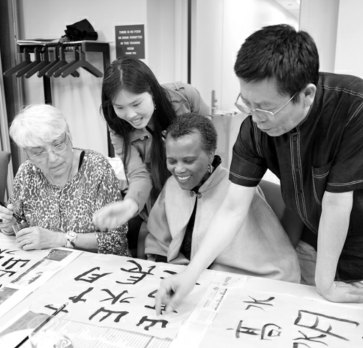
CHINA DAILY
Zhang Xuguang (right)teaches Chinese calligraphy to staff of the United Nations.
A winding path through thick trees leads to a clearing with a villa. It is an unusual scene in the middle of a modern metropolis. Calligrapher and educator Zhang Xuguang, 59, considers his 2,000-square-meter studio hidden beside a busy road in the north of Beijing a wonderland of inner tranquility and beauty-at least before the surrounding area is overtaken by real estate developers.
The studio, Northern Lanting, is named after Lanting Xu (Preface to the Poems Collected from the Orchid Pavilion), one of the greatest masterpieces in Chinese art history created by 4th-century calligrapher Wang Xizhi.
Zhang, also the deputy secretary-in-chief of the China Artists Association, is busily preparing for his next visit to New York City to participate in the United Nations Chinese Language Day events, one of an annual series of activities to highlight the historical and cultural importance of each of the six official languages of the UN.
During his visits to the United States, Zhang met UN Secretary General Ban Ki-moon, who grew up in South Korea, a country with strong cultural influences from China.
"Mr Ban Ki-moon told me he was terrified by Chinese calligraphy when he was a child," Zhang says, recalling their first meeting in 2012. "Because his teacher told him it will take a decade to practice one stroke. But I guess the man became successful due to his perseverance, including his continuous practice of calligraphy.
"Ban emphasized that one attractive part of calligraphy is that there are many rules to follow, which may also echo today's international law, and added that calligraphy had brought him inner peace in the midst of his busy schedule and won him friends from afar."
One of Zhang's students is now Ban Ki-moon's regular calligraphy teacher. Zhang also holds the title of "distinguished professor" of the UN calligraphy class.
"It's an interesting cultural communication promoting Chinese calligraphy among the UN's staff," he says. "They generally prefer viewing caoshu (cursive script), which resembles totems or pictures, and perhaps is easier for Westerners to understand. However, when I taught them writing, they suddenly found that cursive was too difficult to learn, and they all switched to regular script."
Zhang's studio organized a team of 100 people, most of whom are UN staff members, in July 2013, to write a 100-meter-long scroll-the United Nation's charter in Chinese calligraphy-in the Forbidden City.
"The UN is a good platform to promote calligraphy, but it cannot be the only one," Zhang adds.
"Now Confucius Institutes are all over the world, but there are not so many professional calligraphers in their class. That is our next step for cooperation in the future."
Zhang has also opened a calligraphy class in Incheon National University in South Korea, as another channel for regular academic symposiums enhancing communications between Chinese and South Korean calligraphers.
He says he did not think South Koreans would be familiar with Wang Xizhi, but he was surprised by how much they knew. He is now more confident traditional Chinese arts can become better known around the world.
Zhang, who began to teach calligraphy on TV as early as 1990, laments that many people in China have strayed from the right way to learn the art form.
"We have to admit that calligraphy belongs to ancient times because we no longer use the brush as a writing tool," he explains.
"We should take the express train back to look at works from certain periods of history. No matter how creative we are, we have to base our knowledge on the classics and existing rules rather than create something bizarre we have never met before. That differs from other art forms.
"Calligraphy is part of aesthetics and philosophy. It's far beyond a Chinese-language class. That's not only what we should teach foreigners, but also what we should keep in mind in our education. Learning calligraphy is not learning writing per se. It needs more in-depth knowledge about the cultural background, which cannot be obtained overnight.
"A tipsy Wang Xizhi created Lanting Xu at the right moment in the right mood with the right environment. It's impossible to copy that masterpiece later, but we can use our creativity to adapt and spread those existing styles to a new range."
GLANCE
Zhang's tips for calligraphy learners
Whenever you can, practice calligraphy from classic copybooks. Don't write randomly.
Always have a grandiose but approachable model beyond your current capacity. When you have reached that goal, immediately find another higher one.
Read some calligraphy appreciation books and relevant history to learn the basics. Teach yourself the difference between good and bad calligraphy.
Seize every opportunity to attend high-level calligraphy exhibitions.
We recommend:
